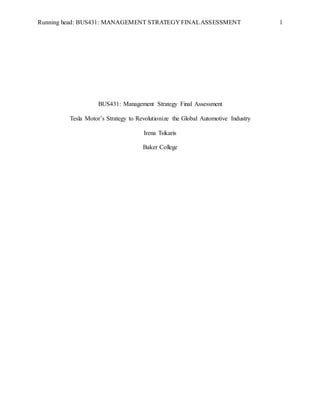Tesla aims to accelerate the world's transition to sustainable energy. The document discusses Tesla's strategy and challenges, including a SWOT analysis, 5 forces analysis, and value chain analysis. It notes Tesla's strengths in design and technology but weaknesses in limited revenues and profitability. Opportunities include growing demand for electric vehicles, but threats include increasing competition from other automakers entering the electric vehicle market.













![BUS431: MANAGEMENT STRATEGY FINALASSESSMENT 14
References
Musk, E. (2006). The Secret Tesla Motors Master Plan (just between you and me). Retrieved
from https://www.teslamotors.com/blog/secret-tesla-motors-master-plan-just-between-
you-and-me
Oston, M. (2016, March). IBISWorld Industry Report 33611a: Car & Automobile Manufacturing
in the US [pdf]. Retrieved from IBIS World Industry Market Research database.
Peterson, K. (2014). Elon Musk says Tesla is following his master plan. Retrieved from
http://www.cbsnews.com/news/elon-musk-says-tesla-is-following-his-master-plan/
Sparks, D. (2015). SWOT Analysis of Tesla Stock. Retrieved from
http://www.fool.com/investing/general/2015/05/13/swot-analysis-of-tesla-stock.aspx
Stringham, E. P., Miller, J. K., & Clark, J. R. (2015). Overcoming Barriers to Entry in an
Established Industry: TESLA MOTORS. California Management Review, 57(4), 85-103.
doi:10.1525/cmr.2015.57.4.85
Tesla Motors. (2016). About Tesla. Retrieved from https://www.teslamotors.com/about
Thompson, A. A., Peteraf, M. A., Gamble, J. E., & Strickland III, A. J. (2016). Crafting and
Executing Strategy (20th ed.). New York, NY: McGraw-Hill Education.
Trejdify. (2013). A SWOT analysis: Can Tesla Motors save the world? Retrieved from
http://blog.trejdify.com/2013/07/a-swot-analysis-can-tesla-motors-save.html](https://image.slidesharecdn.com/730cdedd-24e2-43d3-bd67-434bf128fb11-161013022925/85/ManagementStrategyResearchPaper_TeslaMotors-14-320.jpg)